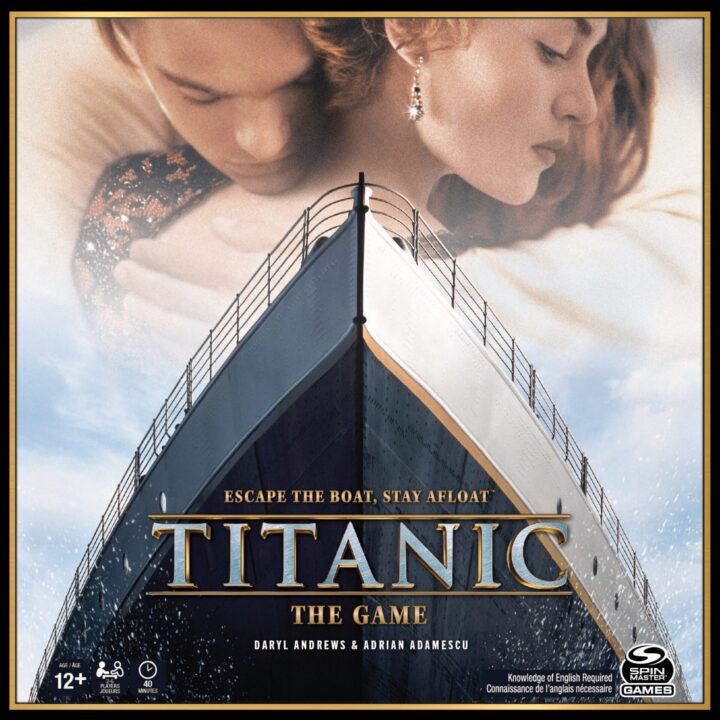Let’s get one thing straight: I never thought I’d spend a Saturday evening shouting at my friends to hurry up and grab a lifeboat. But here I am, reviewing Titanic, a board game that tries to pack the drama, chaos, and hopefully none of the soggy socks, from the famous ship’s last night. I’ve gathered my friends (aka my usual board game test subjects) for a few rounds, and honestly, I may never look at an iceberg the same way again. Is this game a sinking ship or a thrilling ride? Let’s find out together—life jackets optional.
How It Plays
Setting up
Lay out the Titanic board in the center (preferably on a table with no drinks nearby — trust me). Each player picks a character and grabs the matching pawn, a player card, and some starting items. Shuffle the event, item, and objective decks. Place lifeboats around the ship. You’re now ready to panic.
Gameplay
Players take turns moving around the ship, collecting items, helping passengers, and trying not to slip on the theme while water pours in. Each round, new disasters show up — thanks, event deck — so expect blocked doors, panicking party members, and the rising dread of water markers. You’ll scramble for lifeboats while trading and arguing with your friends. And yes, luck from card draws shows up like an iceberg.
Winning the game
To win, you must get your character (and possibly assigned passengers) onto a lifeboat before the ship sinks. If you’re the first to achieve your objective and survive, you win. If you take a wrong turn and end up in the freezing Atlantic (again), you lose. It’s dramatic, sometimes unfair, and always memorable.
Want to know more? Read our extensive strategy guide for Titanic.
How Titanic Sinks or Swims: Gameplay Mechanics & Player Interaction
Let me tell you, Titanic is not your average game night fare. I sat down with my usual group of board game survivors (pun intended) ready to outwit, outplay, and hopefully not outswim each other. Unlike traditional roll-and-move games, Titanic throws you straight onto the doomed ship, giving you a character with a unique set of skills and some very questionable luck (if you’re me, anyway).
The basic mechanic is simple – you run around the ship grabbing items, rescuing passengers, and making a mad dash for the lifeboats. You spend action points to move, pick stuff up, or try to help others, unless of course you’re feeling especially competitive and want to block a friend’s route instead. Trust me, my best mate still hasn’t forgiven me for shoving him into the smoking room while the water rushed in. I call it “emergent gameplay,” he calls it “the greatest betrayal since Monopoly.”
Now, what really makes Titanic stand out is how players interact. Every turn, the tension rises, much like the water level. You *can* work together, but honestly, when you see that lifeboat fill up, you’ll start calculating how much you really value friendship. There’s a tug-of-war between heroism and self-preservation, and some wild table talk. Luck plays a part, especially when drawing event cards, but strategy matters too – knowing which rooms to visit or whose path to sabotage is key. I did grumble a bit at how chaos (and bad card draws) can totally sink a good plan, but hey, chaos probably sums up the original Titanic as well.
Next up, I’ll talk about why the deck of the Titanic feels like its own character, complete with haunting music and heart-thumping panic. Stay tuned for Theme and immersion – no lifeboat required!
Theme and Immersion: Feeling the Chill of the Titanic Setting
Let me tell you, if you want a board game night that feels like a movie, Titanic delivers. As soon as I opened the box and saw the board, I started humming “My Heart Will Go On” and pretending my glass of water was the icy Atlantic. The game absolutely nails the feeling of being on the doomed ship. You have characters with real names from the passenger list, and you have to work hard to get them to the lifeboats. There was genuine panic at my table as we scrambled between decks, hunting for life vests and plotting our escape. It’s almost like you’re watching the timeline unfold in real time—just with more snacks and less freezing water.
The designers worked hard to make the drama and tension of the Titanic disaster come to life. It’s not just moving meeples and rolling dice; every turn has you picturing yourself on that cold, tilting deck. Sometimes I found myself yelling, “There’s room on the door!” at my friends, and that’s when I knew the game’s theme was pulling us right in. The event cards, the little story snippets, and the constant threat of disaster all make the gameplay feel epic and intense. Even the way the ship “sinks” on the board is pretty clever and ramps up the immersion.
If you want a game that sweeps you up and almost makes you check if you packed your own life jacket, this is it. Next, I’ll have a look at whether Titanic’s shiny bits and pieces match its big, dramatic heart—or if they’re just soggy napkins.
Sturdy Lifeboats and Eye-Catching Waves: Titanic’s Component Quality and Artwork
Let me just say, opening the Titanic board game box is like lifting the lid on a time capsule—if that time capsule was also full of panic and way too many tiny cardboard lifeboats. The components are solid. The boards don’t warp like the actual Titanic did (too soon?), and nothing feels like it’ll fall apart faster than Jack and Rose’s relationship. The cards? Thick enough to survive my mate Steve’s greasy pizza hands, which is a tough test for any game.
The standout piece here is the huge board, shaped like the actual ship, which always turns heads when you set it up. It’s got detailed artwork: you can spot the grand staircase, deck chairs, and even the lifeboats—which you’ll be scrambling for, trust me. Everything looks crisp and thematic, pulling you right in (but not under).
The character tokens have a vintage charm. I always appreciate when a game resists the urge to slap in generic meeples and instead gives us something with personality. Even the instruction book gets points for looking like it washed ashore from 1912—if only it floated as well.
Now, not everything’s perfect. Punching out bits can get fiddly, and there are more little tokens than I have excuses for being late to game night. If you hate sorting, prepare for an iceberg of a setup time.
But is Titanic’s beauty just skin-deep, or will you want to play it more than once? Grab your oar, because up next I’m talking replay value and whether luck sinks your hopes or lets you come up for air.
How Many Times Will Titanic Stay Afloat On Your Table?
Replay value! The magic words every board game group wants to hear. When it comes to Titanic, I figured I’d be wrangling my friends to play again and again, reliving the chaos of lifeboat hopping and ‘accidently’ locking rival passengers in steerage. But, like hitting a chilly iceberg, reality struck after a handful of plays.
Here’s the deal, folks: Titanic has a neat idea and makes a good splash on game night. The roles and rescue scenarios change a bit each game, and arguing over ‘who really deserves the last space in a lifeboat’ never seems to get old. But after the third game, my group started feeling deja-vu as the mechanics played out in much the same way. The drama is strong, but the script gets familiar.
Now, let’s talk about luck. Is Titanic fair? Well, mostly. But I did watch my buddy Stan draw three bad event cards in a row while I waltzed away in a lifeboat—and no, he hasn’t forgiven me. The game tries to balance skill and chaos, but luck can give your plans a one-way ticket to Davy Jones’ locker. You can’t rely just on clever moves—you’ll need some good fortune, which rubs me the wrong way when a victory feels more like rolling dice than outsmarting friends.
So, do I recommend Titanic? If you want a dramatic game, sure! Just don’t expect every play to feel brand new—or totally fair. Bring your lucky socks and leave your grudge at the door!
Conclusion
So, after braving the icy decks of Titanic with my friends, I have to say: it’s a wild ride, but not always smooth sailing. The theme is brilliant—you really feel the panic and drama—but luck sometimes tosses your plans overboard. The components look great, but the setup can be as awkward as dancing with an iceberg. If your group loves tense, dramatic moments (and doesn’t mind a bit of randomness), you’ll have a blast. But if you crave strategy and full control, you might find yourself all wet. That’s a wrap for my Titanic review—now somebody pass me a lifeboat, please!


